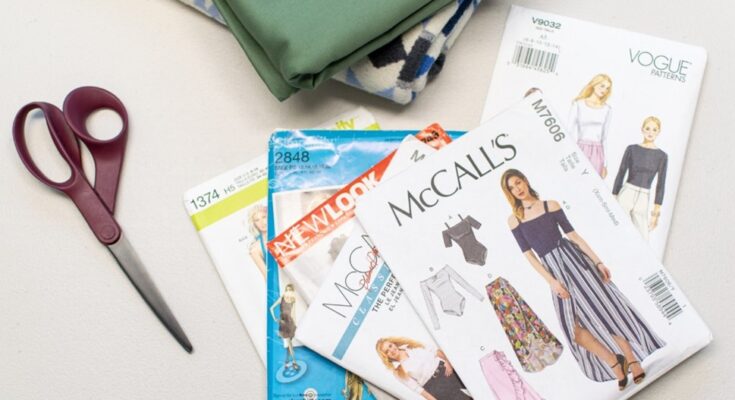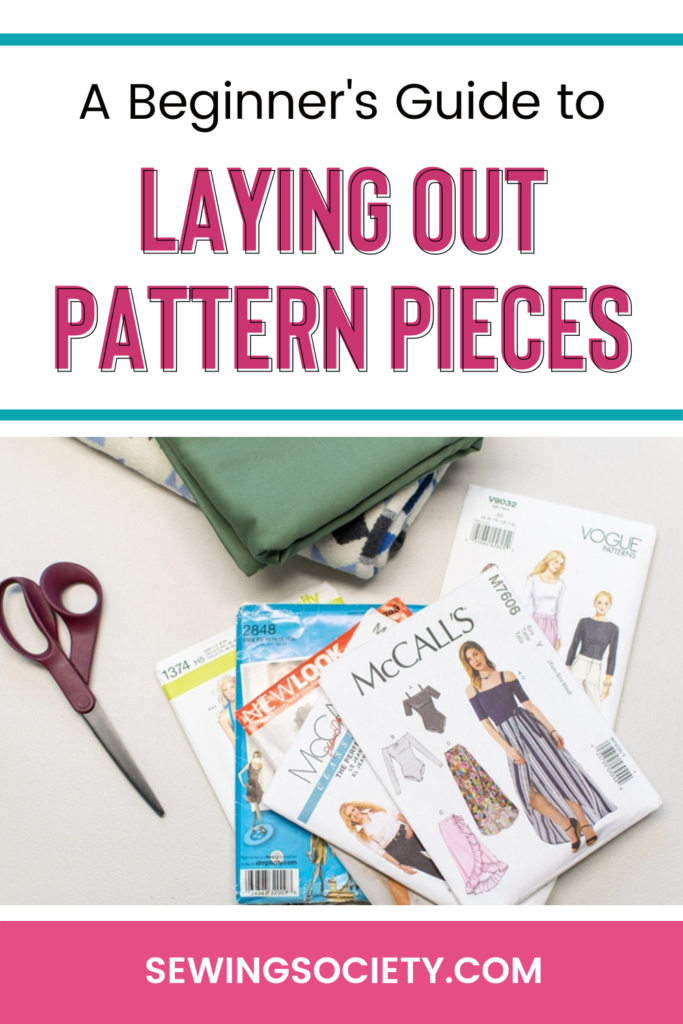Disclosure: This post may contain affiliate links. I earn a small commission when you click a link and make a purchase. Thanks for supporting SewingSociety.com!
When you’re ready to start a sewing project, it’s super important that you don’t just throw your pattern pieces onto your fabric wherever they’ll fit and start cutting. This haphazard approach could result in a garment that doesn’t hang correctly on your body.
Remember that working too quickly leads to mistakes…
You need to carefully plan where each pattern piece will go on your fabric and ensure that the grainline matches your pattern. This post will show you how to do that and explain everything else you need to know about laying out pattern pieces.
Taking the time to lay out your pattern pieces accurately will help you achieve professional results from your sewing.
Contents
Cut and Press Your Pattern
When you take a pattern out of the envelope (or print one from your computer), the first thing you need to do is cut out your pattern pieces. Make sure to check your instructions to ensure that you cut out all the right you need. And, don’t use your fabric scissors for this step!
Once all your pattern pieces have been cut out, they’ll be a little wrinkly from being folded up in the pattern envelope. Even taped-together PDF patterns can have some wrinkles. It’s essential to get your pattern pieces flat before placing them on your fabric. This will help you to cut your fabric more accurately.
Set your iron to a low heat setting with no steam. Then, slide your iron across each pattern piece to remove the wrinkles. Be careful not to linger on any one spot for too long, especially on delicate tissue paper patterns. You don’t want to accidentally burn or scorch your pattern!
Check the Pattern Layout Guide
Next, find the cutting layout section in your pattern instructions. This section usually includes a few different layout options based on the version of the pattern you are sewing and the width of your fabric.
Keep these layout suggestions in mind as you go forward — following the layout guide will ensure that your pieces fit on your fabric and are cut in the correct orientation. However, once you understand the process of laying out pattern pieces, you can always adjust the layout to your needs. You don’t have to follow the layout guidelines in the pattern instructions.
If reading a pattern and pattern instructions is completely foreign to you, you might find this post on How to Read a Sewing Pattern useful before coming back to this one.
Lay Out Your Fabric
It’s now time to lay out your fabric on a table, the floor, or a cutting mat. Unless you’re cutting a specialty fabric, such as velvet, sequins, or vinyl, you’ll be cutting your fabric in two layers. To prepare your fabric, fold it in half lengthwise so that the selvage edges are matched up.
Traditionally, fabric is cut while folded with right sides together. However, it really doesn’t make a difference if you fold it with right or wrong sides together for cutting. In fact, I find it easier to place my pattern pieces where I want them on a printed fabric if I fold it with the right sides facing out!
Make sure that your fabric is lying flat and that the fold at the bottom is straight. Readjust your fabric until all the edges are aligned as closely as possible. If your fabric is wrinkly, it helps to press it flat before trying to lay it out for cutting.
Lay Your Pattern Pieces on Your Fabric
With your fabric prepared, it’s time to lay out those pattern pieces! The simplest way to do this is to select one of the layout options from the pattern instructions and arrange your pieces on your fabric as suggested.
However, as long as you keep the pattern pieces on grain (more on that in the next section), you can arrange the pieces in whatever order you like.
Watch the Grainlines
You’ll need to watch those grainlines! The straight grain runs exactly parallel to the selvage edge of your fabric. You can typically see straight threads running across your fabric along the grain if you look closely.
Each pattern piece will have a double-sided, straight arrow printed on it. This arrow should be aligned with the straight grain. On some pattern pieces, the arrow may run vertically, on some it may be horizontal, or it can even be diagonal. The key is to keep that arrow on the straight grain.
You can eyeball the placement if you like, by looking at the threads running across your fabric. To be more precise, you can measure over from the selvage along the length of the arrow to make sure it’s the same distance from the selvage all the way down.
Keeping your pattern pieces on grain is extremely important for making a garment that will hang correctly and not twist. If your pieces are cut in any direction with no consideration to the grain, they will not hang straight once stitched together.
Check for Pieces Cut on the Fold
Some pattern pieces may need to be cut with one edge on the fold of your fabric. The reason for this is so that after cutting, the piece can be unfolded into one large piece that’s symmetrical on each side. Examples of pieces commonly cut on the fold include bodice and skirt fronts and backs, sleeves, and waistbands.
If a piece needs to be cut on the fold, it will have a double-sided arrow with angled ends and the words “center fold” along one edge of the pattern piece. The edge that the arrows point to needs to be carefully aligned with the fold in your fabric.
Cut Out Your Fabric
Once your pattern pieces have been arranged on your fabric, they need to be secured in place. You can do this with sewing pins or by weighing them down with pattern weights. I highly recommend using pattern weights only with a rotary cutter because scissors tend to shift your fabric and pattern weights out of place as you cut.
With the pattern pieces secured to your fabric, carefully cut around the edges of each piece with a rotary cutter or scissors. Focus on cutting as accurately along the pattern lines as possible.
Also Read: 4 Mistakes to Avoid When Cutting Out Pattern Pieces
Add Pattern Markings
After all the pattern pieces have been cut out, you’ll need to transfer the pattern markings from the pattern to your fabric. I love to use heat-erasable markers for this.
First, go through and clip ¼ inch into each marked notch along the edges of each pattern piece. Next, use a fabric marker to draw a dot directly below each marked large or small circle, making sure to mark both pieces of fabric. Finally, transfer any stitching lines marked on the pattern to your fabric with a fabric marker.
Now go forth and cut out your pattern pieces with confidence!
P.S. If you’re looking for a pattern, browse this massive list of indie pattern companies.
Share this post on Pinterest!













